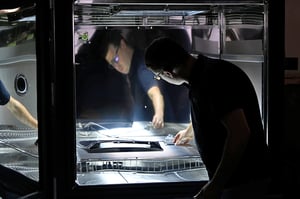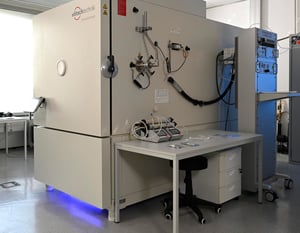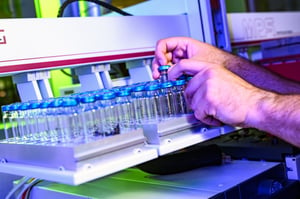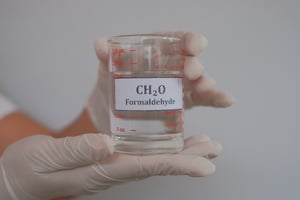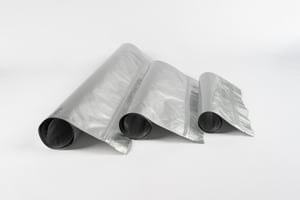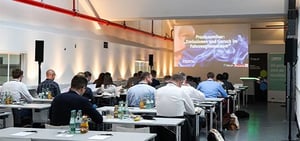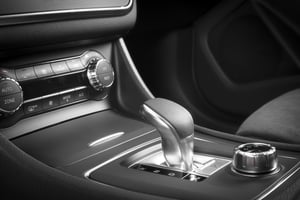
Fogging
Determination of the fogging behavior of materials used in vehicle interiors
FOGGING TEST IN THE
AUTOMOBILE INTERIOR
MATERIAL TESTS UNDER SIMULATED CLIMATIC CONDITIONS
In the automotive industry, reliability and durability are among the most important requirements for materials and components. Climate tests and heat ageing tests play a central role here, as they realistically simulate the effects of extreme environmental conditions such as high temperatures, strong temperature fluctuations and humidity.
With our accredited test procedures, we support automotive suppliers and OEMs in ensuring the quality and safety of their products. Our tests cover a wide temperature range from -60 °C to +180 °C and humidity from 10 % to 98 % and are carried out in accordance with OEM standards. This enables us to ensure that your components function even under the most difficult conditions and meet the high requirements of the automotive industry.
From plastic and elastomer components to electronic control units, seat materials and batteries - we offer customized testing for a wide range of components and materials. Our testing capacities range from small individual parts to complete vehicles. With state-of-the-art testing technology and comprehensive expertise, we ensure that your products can withstand the challenges of extreme climatic conditions and remain reliable in the long term.

Fogging test methods
- DIN 75201-A (reflectrometric)
- DIN 75201-B (gravimetric)
- PV 3015 (Volkswagen)
- GMW 3235-A (General Motors Worldwide)
- PSA D45 1727
- and much more.
Test methods / specifications
- DBL 5471
- VW PV 1200
- Jaguar TPJLR.52. 353
- BMW PR 303. 5
- MBN 10494-8 § 5. 4
- MBN 55555-4 § 5.1 WKW
- VW PV 2005-A
- VW 80000
- LV 124
- and much more.
Are you looking for an exam? Standard? Specifications?
Accredited & certified tests
CONTACT OUR EXPERTS
Description. Lorem ipsum dolor sit amet, consetetur sadipscing elitr, sed diam nonumy eirmod tempor invidunt ut labore et
- Tab Title






- Typical tests before and after ageing
- Test facilities
Typical tests before and after ageing
Before
- Visual evaluation
- Color and gloss measurement: metrological determination of color and gloss level
- Photogrammetry
- Scratch test
- Abrasion resistance/ abrasion resistance
- Emission and odor testing in the vehicle interior
Afterwards
- Visual evaluation
- Color & gloss: metrological change of color and evaluation according to the gray scale
- Photogrammetry
- Peel test (decorative goods )
- Foam adhesion
- Hardness test
Test facilities
- Test room volume: Our test rooms vary in size from 0.9 m³ to 46 m³ and therefore offer sufficient space for everything from small components to complete vehicles. This flexibility enables us to test a wide variety of materials andcomponentsunderlaboratoryconditions.
- Temperature range: Our test equipment is able to simulate temperatures from -60°C to +180°C. This enables comprehensive tests on temperature resistance and the ageing behavior of materials in hot and cold conditions.
- Humidity range: With a relative humidity of 10% to 98% , our test systems cover a wide range of climatic conditions. From dry desert conditions to the high humidity found in tropical climates, we are able to test the moisture resistance of materials and components.
Frequently asked questions about the fogging test
The sample quantities required for a fogging test depend on the standard and the test method used. Here are the general guidelines:
1. standard DIN 75201 (type A and type B)
-
Type A (glass plate method):
A sample quantity of 10 cm² is typically required. The sample is placed on a heated plate in a sealed chamber and the volatiles released condense on a glass plate above. -
Type B (aluminum foil method):
Similar to type A, a sample volume of approximately 10 cm² is used. However, the volatile substances condense on a cooled aluminum foil.
2. standard ISO 6452 (international standard)
- Sample quantity:
Again, a sample size of about 10 cm² is typically required to evaluate the amount of volatiles released at elevated temperature.
3. other specific requirements
Depending on the specific requirements of the customer or OEM standards, sample quantities may vary. It is important to check the respective standards or test requirements carefully.
Method A - Reflectometric method:
- Principle: This method measures the change in reflectivity on a glass plate on which volatile components from the material sample are deposited.
- Procedure: A material sample is heated in a beaker while a glass plate above it is cooled to 21°C. The temperature difference causes the volatile components to condense on the glass plate. The reflectance index of the fogged glass plate is then measured to determine the amount of condensed material.
- Application: This method is particularly suitable for materials for which an exact determination of the optical fog effect is required.
Method B - Gravimetric method:
- Principle: This method measures the weight of condensed volatiles on an aluminum foil.
- Procedure: The material sample is heated in a beaker while an aluminum foil disc is cooled to 21°C. After 16 hours, the amount of condensed material on the foil is weighed.
- Application: This method is ideal for an accurate quantitative determination of the amount of condensed volatiles.
CONTACT US
ENVIRONMENTAL SIMULATION
FREQUENTLY ASKED QUESTIONS ABOUT CLIMATE AUDITS
Yes, we carry out tests in accordance with national and international standards as well as OEM-specific requirements and are accredited for the most important tests. Find out more about our accreditations here.
